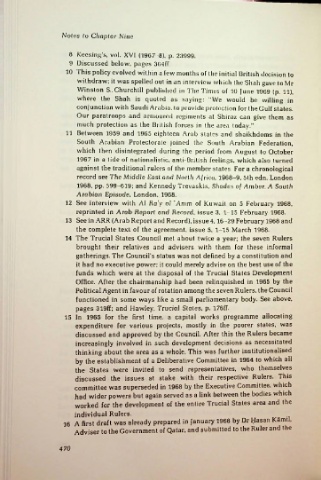Page 496 - Truncal States to UAE_Neat
P. 496
Notes to Chapter Nine
8 Keesing’s, vol. XVI (1967-8), p. 23999.
9 Discussed below, pages 364ff.
10 This policy evolved within a few months of the initial British decision to
withdraw; it was spelled out in an interview which the Shah gave to Mr
Winston S.. Churchill published in The Times of 10 June 1969 (p. 11),
where the Shah is quoted as saying: "We would be willing in
conjunction with Saudi Arabia, to provide protection for the Gulf states.
Our paratroops and armoured regiments at Shiraz can give them as
much protection as the British forces in the area today."
11 Between 1959 and 1965 eighteen Arab slates and shaikhdoms in the
South Arabian Protectorate joined the South Arabian Federation,
which then disintegrated during the period from August to October
1967 in a tide of nationalistic, anti-British feelings, which also turned
against the traditional rulers of the member states. For a chronological
record see The Middle East and North Africa, 1968-9, 5th edn, London
1968, pp. 599-619; and Kennedy Trevaskis, Shades of Amber, A South
Arabian Episode, London, 1968.
12 See interview with Al Ra’y al 'Amm of Kuwait on 5 February 1968,
reprinted in Arab Report and Record, issue 3, 1-15 February 1968.
13 See in ARR (Arab Report and Record), issue 4,16-29 February 1968 and
the complete text of the agreement, issue 5, 1-15 March 1968.
14 The Trucial Slates Council met about twice a year; the seven Rulers
brought their relatives and advisers with them for these informal
gatherings. The Council’s status was not defined by a constitution and
it had no executive power; it could merely advise on the best use of the
funds which were at the disposal of the Trucial States Development
Office. After the chairmanship had been relinquished in 1965 by the
Political Agent in favour of rotation among the seven Rulers, the Council
functioned in some ways like a small parliamentary body. See above,
pages 319ff; and Hawley, Trucial Stales, p. 176ff.
15 In 1965 for the first time, a capital works programme allocating
expenditure for various projects, mostly in the poorer states, was
discussed and approved by the Council. After this the Rulers became
increasingly involved in such development decisions as necessitated
thinking about the area as a whole. This was further institutionalised
by the establishment of a Deliberative Committee in 1964 to which all
the States were invited to send representatives, who themselves
discussed the issues at stake with their respective Rulers. This
committee was superseded in 1968 by the Executive Committee, which
had wider powers but again served as a link between the bodies which
worked for the development of the entire Trucial States area and the
individual Rulers.
16 A first draft was already prepared in January 1968 by Dr Hasan Kamil,
Adviser to the Government of Qatar, and submitted to the Ruler and the
470

